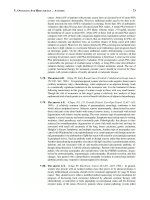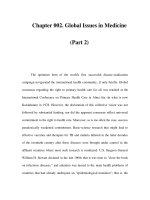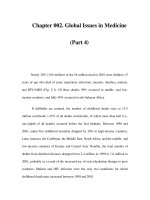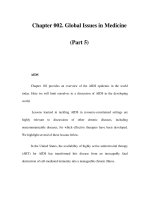Chapter 002. Global Issues in Medicine (Part 3) pdf
Bạn đang xem bản rút gọn của tài liệu. Xem và tải ngay bản đầy đủ của tài liệu tại đây (15.19 KB, 5 trang )
Chapter 002. Global Issues in Medicine
(Part 3)
The Economics of Global Health
Political and economic concerns have often guided global health
interventions. As mentioned previously, early efforts to control yellow fever were
tied to the completion of the Panama Canal. However, the precise nature of the
link between economics and health remains a matter for debate. Some economists
and demographers argue that economic development is the key to improving the
health status of populations, while others maintain that ill health is the chief barrier
to development in poor countries. In either case, investment in health care, and
especially in the control of communicable diseases, should lead to increased
productivity. The question is where to find the necessary resources to start the
predicted "virtuous cycle."
International financial institutions, including the World Bank and the IMF,
have counseled limited investments and the capping of social expenditures in
health and education. The socioeconomic argument was that a balanced budget
and a "friendly investment climate"—that is, privatization, deregulation, decreased
trade barriers, devalued currencies, and debt repayment—would favor
development and thus improve health outcomes. The limitations on social-sector
spending recommended for many poor countries by the World Bank and the IMF
from the 1970s through the 1990s tended to confirm the opposite view. In the
poorest countries, already-tiny health-sector budgets were further constricted.
Moreover, health-sector spending in many poor countries channeled a majority of
resources toward city hospitals that served mostly élites who were able to pay;
consequently, in the past quarter-century, little spending went toward addressing
the problems that most affected poor people in poor countries.
Since 1999, spurred by the leadership of the Gates Foundation and the
growing interest in addressing novel and persistent challenges such as AIDS,
spending on health in poor countries has increased, with $40 billion in new funds
earmarked for the discovery and development of drugs and diagnostics targeting
diseases of the poor; for comprehensive responses to the AIDS, TB, and malaria
epidemics; for vaccine development and delivery; and even for improved methods
of data collection in resource-poor settings. Nevertheless, in order to reach the
United Nations' Millennium Development Goals, which include targets for poverty
reduction, universal primary education, and gender equality, spending in the health
sector will have to be further increased and sustained. To determine by how much
and for how long, it is imperative that we improve our ability to assess the global
burden of disease (GBD) and to plan interventions that more precisely match the
need, which is glaring but often poorly understood. Refining metrics is an
important task for global health: only recently have we had solid assessments of
the GBD. Such assessments may serve as preliminaries or as correctives to
effective interventions among the poor.
Life Expectancy and Global Burden of Disease
Since the late 1980s, serious efforts have been made to calculate the GBD.
The first GBD study, conducted in 1990, laid the foundation for the first report on
Disease Control Priorities in Developing Countries (DCP1) and for the World
Bank's 1993 World Development Report entitled Investing in Health. These
efforts represented a major advance in our understanding of health status in
developing countries. Investing in Health has been especially influential: it
familiarized a broad audience with cost-effectiveness analysis for specific health
interventions and with the notion of disability-adjusted life years (DALYs). The
DALY, which has become a standard measure of the impact of a specific health
condition on a population, combines in a single measure both absolute years of life
lost and years lost due to disability for incident cases of a condition.
The second GBD analysis was carried out on health data from 2001. The
latter report reflects growth in the available data on health in the poorest countries
and in our capacity to measure the impact of specific conditions on a population.
Yet, even in 2001, only 107 of 192 nations surveyed had reliable information on
the causes of deaths within their own borders. It is essential to expand efforts to
collect the most basic health data; this task falls to the WHO, national
governments, and certain academic institutions. The lack of complete data has led
to considerable uncertainty in estimates of overall mortality. The level of
uncertainty ranges from as low as 1% for estimates of all-cause mortality in
developed countries to well over 50% for disability resulting from diseases for
which surveillance mechanisms are incomplete. As analytic methods and data
quality have improved, however, important trends can be identified in a
comparison of GBD estimates from 1990 and 2001.
Of the 56 million deaths worldwide in 2001, one-third were due to
communicable diseases, maternal and perinatal conditions, and nutritional
deficiencies. While the proportion of all deaths attributable to these causes was
unchanged from 1990, the share of all deaths due to the communicable disease
HIV/AIDS grew from just 2% to an astonishing 14%. If these deaths were
excluded, the fraction of all deaths related to communicable diseases, maternal and
perinatal conditions, and nutritional deficiencies dropped from one-third to one-
fifth. Of the deaths making up that one-fifth of the total figure, 97% occurred in
middle- and low-income countries. The leading cause of death among adults in
2001 was ischemic heart disease, accounting for 17.3% of all deaths in high-
income countries and for 11.8% in middle- and low-income countries. In second
place was cerebrovascular disease, which accounted for 9.9% of deaths in high-
income countries and for 9.5% of deaths in middle- and low-income countries.
While the third leading cause of death in high-income countries was tracheal,
bronchial, and lung cancers (which accounted for 5.8% of all deaths), these
conditions do not even register in the top 10 places in middle- and low-income
countries. Of the 10 leading causes of death in poorer countries, 5 were
communicable diseases; in high-income countries, however, only 1 communicable
disease—lower respiratory infection—was ranked among the top 10 causes of
death.









